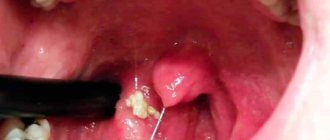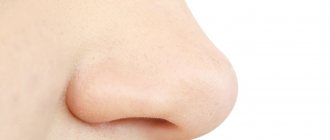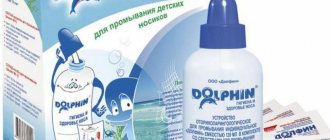A runny nose is not always observed when the nose is swollen. Some patients who experienced this phenomenon did not notice mucous discharge or other cold symptoms. Most people simply do not pay attention to this problem, but in vain.
After all, swelling of the nose without a runny nose may be a sign of a certain pathological process in the body, due to which a severe form of complications may develop. Let's try to find out what is the reason for the appearance of such symptoms, and how this disease can be dealt with with the help of drug therapy and traditional recipes.
Causes of swelling
The mucous membrane has a protective function. It prevents germs, dust, bacteria and allergens from entering the body through the nose and throat.
The nasal mucosa is covered with ciliated epithelium, which consists of a large number of cilia with goblet cells. The latter have a depression, and it is in it that mucus is produced, which helps moisturize the nasopharynx.
The cilia block the passage of infections by making oscillatory movements. When a person develops a cold, the vibration of the cilia slows down. They are no longer able to fully cope with the protective function. This entails swelling and snot.
The main reasons that may cause swelling of the nasal mucosa without a runny nose in adults and children include:
- Dry air. It leads to drying out of the nasopharynx, which may result in swelling.
- Hormonal changes in the human body. Such changes during pregnancy can cause swelling of the nasal passages without rhinorrhea. This condition is considered normal from a physiological point of view and does not require treatment.
- Allergies. Often, swelling in the nose is caused by exposure to allergens on the mucous membrane. Basically, during swelling from allergies, a number of other symptoms are observed: watery eyes, itching in the nasal passages, burning and severe sneezing. In this condition, breathing becomes difficult, but no nasal mucus is produced.
- Vasoconstrictor drops to facilitate breathing through the nose. Their uncontrolled use causes addiction to the body. If you abuse the drug for a long time, it will stop having a healing effect and bringing relief to the patient. This can provoke swelling of the mucous membrane without secretions and sputum.
- An abnormality in the structure of the nasal septum or its defects. The main reason why swelling of the nasal sinuses is observed may be an anomaly in the structure or acquired deformation of the nasal septum.
- Inflammatory processes in the maxillary sinuses. Sinusitis can also cause swelling.
- Nasal polyps and adenoids. All this disrupts the respiratory process and can occur without the presence of snot. If the adenoids have grown due to infection, then, in general, rhinorrhea is not observed when the nose is swollen.
What symptoms can accompany the edematous condition? This includes the following:
- Feeling of dryness in the nasal passages. May be accompanied by the formation of crusts.
- Severe sneezing. Typically in the morning or on the street.
- A burning sensation in the nostrils when the patient tries to breathe through the nose.
- Tearing.
- Pain in the head.
- Partial or complete absence of smell is rare.
- Hoarse notes in the voice.
Symptoms of swelling of the nasal mucosa
Symptoms of edema are classified into 2 types. The table below provides information on this issue:
| View | Symptom |
| Dysfunctional | The nose does not breathe at all, a limited amount of oxygen enters the brain, so blood circulation slows down and short-term memory loss occurs. The patient feels weakness in the arms and legs. |
| With swelling and nasal congestion, the patient's olfactory function weakens. Added to this is loss of taste and decreased appetite. | |
| The voice changes. | |
| There appears copious discharge and a special liquid - exudate, consisting of formed blood proteins. | |
| Inflammatory | The mucous membrane of the olfactory organ becomes dry, which causes an increase in the area of edema. The patient feels a burning sensation in both nostrils. |
| Temperature increase. | |
| The eyes become irritated and tears appear. | |
| There is a sneezing reflex due to dryness. | |
| Headaches caused by a lack of oxygen in the brain due to swelling. |
If a baby has swelling in the nose, but without a pronounced runny nose, then he may suffocate when feeding.
Features of treatment
Nasal swelling can be relieved only after a comprehensive diagnosis of the patient has been carried out in a medical facility.
It should consist of a full examination by a specialist (otolaryngologist), various tests (especially if the doctor suspects that the disease is allergic), and x-rays (if there is a suspicion of polyps or a foreign object in the nasal cavity).
Only if these conditions are met can the patient be prescribed medication. In rare cases, when the problem is caused by mechanical trauma or tumor, the patient may require surgery.
Therapy for swelling of the nasal mucosa includes taking medications and traditional medicine recipes. The combination of these measures gives good results and promotes a speedy recovery.
Drug therapy
Classical therapy aimed at eliminating the problem of swelling cannot be imagined without taking the following groups of medications:
- Drops and sprays with vasoconstrictor properties. Their use relieves congestion and facilitates nasal breathing.
- Products in the form of ointments like the popular “Star” balm.
- Medicines in the form of lozenges used to treat colds. They help relieve the swelling of the mucous membrane of the nasopharynx and tonsils.
- Antihistamine medications prescribed in cases where the disease is allergic in nature.
- Drugs that have general strengthening properties and increase the body's immune defense. Homeopathy-related remedies are especially good.
Therapeutic measures used in the treatment of the problem of swelling of the nasal mucosa include inhalation procedures. However, they can only be used when the disease is not accompanied by fever.
At slightly elevated temperatures (up to 37.5 degrees Celsius), inhalation using a nebulizer is acceptable. This inhalation device can also be used in cases where small children, including infants, are sick.
How and with what to treat nasal swelling without a runny nose
Swelling due to nasal congestion without a runny nose is treated depending on the cause. Consequently, first of all, the essence and diagnosis of the pathology is determined, then the method of treatment. Swelling of the mucous membrane of the olfactory organ is a symptom of various diseases.
The doctor prescribes treatment with certain medications when he determines the nature of the symptom: pathogenetic or symptomatic.
In the first case, the doctor examines the patient and, if the symptom is attributed to a certain pathology, prescribes special drops and medications to the patient. But there are difficult cases. For example, treatment of advanced sinusitis, the main symptom of which is swelling in the nasal sinuses with severe runny nose, is carried out using punctures. If a tumor occurs with accompanying swelling and nasal congestion, it is treated with surgery.
We recommend further reading What is a puffy face or pastiness: causes and treatment
In the second case, the goal of treatment is to eliminate the symptom. Swelling usually bothers people with allergies and acute respiratory infections. A symptom of allergies and the initial stage of a cold, when swelling occurs in the nasal sinuses without a runny nose, is treated with the use of special nasal drops. And treatment of rhinitis with swelling and nasal congestion is carried out using novocaine blockades and ultraviolet irradiation.
Allergic nature of edema without runny nose
Allergy sufferers often do not consult a doctor and choose a remedy for allergic reactions themselves. The choice falls on vasoconstrictor drops. Drugs that constrict blood vessels counteract rhinitis: the swelling in the lining of the nasal passages gradually subsides, and it becomes easier for the patient to breathe. However, it is not recommended to use drops for more than 7 days, otherwise dependence and subsequent complications will develop. It is important to take this into account when treating children.
Today, a popular remedy from this group is isolated - Xylometazoline. Application is extended for 3 days. When a child or adult has impaired respiratory function and difficulty breathing due to swelling without a runny nose, it is recommended to use the above drops.
Traditional medicine for swelling without a runny nose
There are thousands of remedies for nasal swelling without a runny nose in folk medicine. We suggest considering the most effective ones:
- A mixture of onions and garlic. The ingredients are crushed and then placed on the board. A patient with nasal congestion and swelling inhales the vapors of the above vegetables. The procedure relieves irritation and heals the mucous membrane of the olfactory organ.
- According to folk recipes, iodine has anti-inflammatory properties. At night, the patient’s feet are rubbed with this ingredient. Warm woolen socks are put on top. This method works well if there is swelling without a runny nose.
- Lemon juice solution. The juice is diluted with boiling water. A patient with nasal swelling needs to inhale and exhale the vapors of the resulting solution. The result of the procedure is achieved if you take several inhalations and exhalations of the solution per day. You can use the mixture in another way: cotton pads are moistened and inserted into the nostrils for about 15 minutes. Bacteria are destroyed, the walls of blood vessels become strong, and the swelling gradually subsides.
- Cedar essential oil. Using this ingredient, inhalations are prepared for swelling without a runny nose. A few drops of ether are added to a 5 or 5 liter pan with boiling water. The patient bends over the container, covers himself with a warm blanket and alternately inhales and exhales. Inhalations are also prepared using boiled potatoes.
Preventive actions
To prevent the problem of swelling of the nasal mucosa without snot and other unpleasant manifestations of this type of rhinitis, follow simple preventive rules. These include the following:
- regular examinations by an otolaryngologist. Thanks to this, it is possible to identify serious diseases such as polyps or tumor formations in the nasal cavity in the early stages. This will allow you to start treatment on time and effectively fight the disease;
- maintaining personal hygiene;
- regular wet cleaning to reduce the risk of allergic diseases;
- timely treatment of diseases associated with the respiratory system;
- control of air humidity levels in living spaces;
- avoiding situations fraught with hypothermia;
- physical education, swimming in the pool, hardening;
- regular walks in the fresh air.
Whatever therapeutic measures are chosen to combat the problem of swelling of the mucous membrane of the nasal passages without a runny nose, you cannot self-medicate. In many cases, it is the main reason for the deterioration of the situation.
It is especially unacceptable to choose medications on your own in order to treat a child. Medicines and other physiotherapeutic procedures to eliminate this painful condition are prescribed only by an ENT doctor after diagnosis and receipt of test results.
Preventing nasal congestion
To prevent the inflammatory process of swelling of the nasal mucosa without a runny nose, you must follow basic rules:
- Keep air humidity normal. Special air humidifiers will help in this matter.
- Rinsing the olfactory organ with saline solution.
- Exclusion from household items that cause attacks in an allergic person. Allergens usually include wool, dust and flowers.
- Constant dusting in indoor areas.
- Air filtration in rooms. This is done using air conditioning or opening a window.
- Drinking enough warm water throughout the day. Relevant for colds.
- Activities that strengthen the immune system. These include running and strength training.
- Compliance with the temperature regime is at least 23 degrees in the room.
- Intake of vitamins B and C in the diet. You can replace vitamin C with ascorbic acid.
The recommendations described above will help prevent swelling of the olfactory organ during colds and allergies.
Galina Polovnikova / author of the article
I write articles in various areas that, to one degree or another, affect such a disease as edema.
We recommend further reading How long does swelling on the lips last after lip augmentation and how to reduce it








